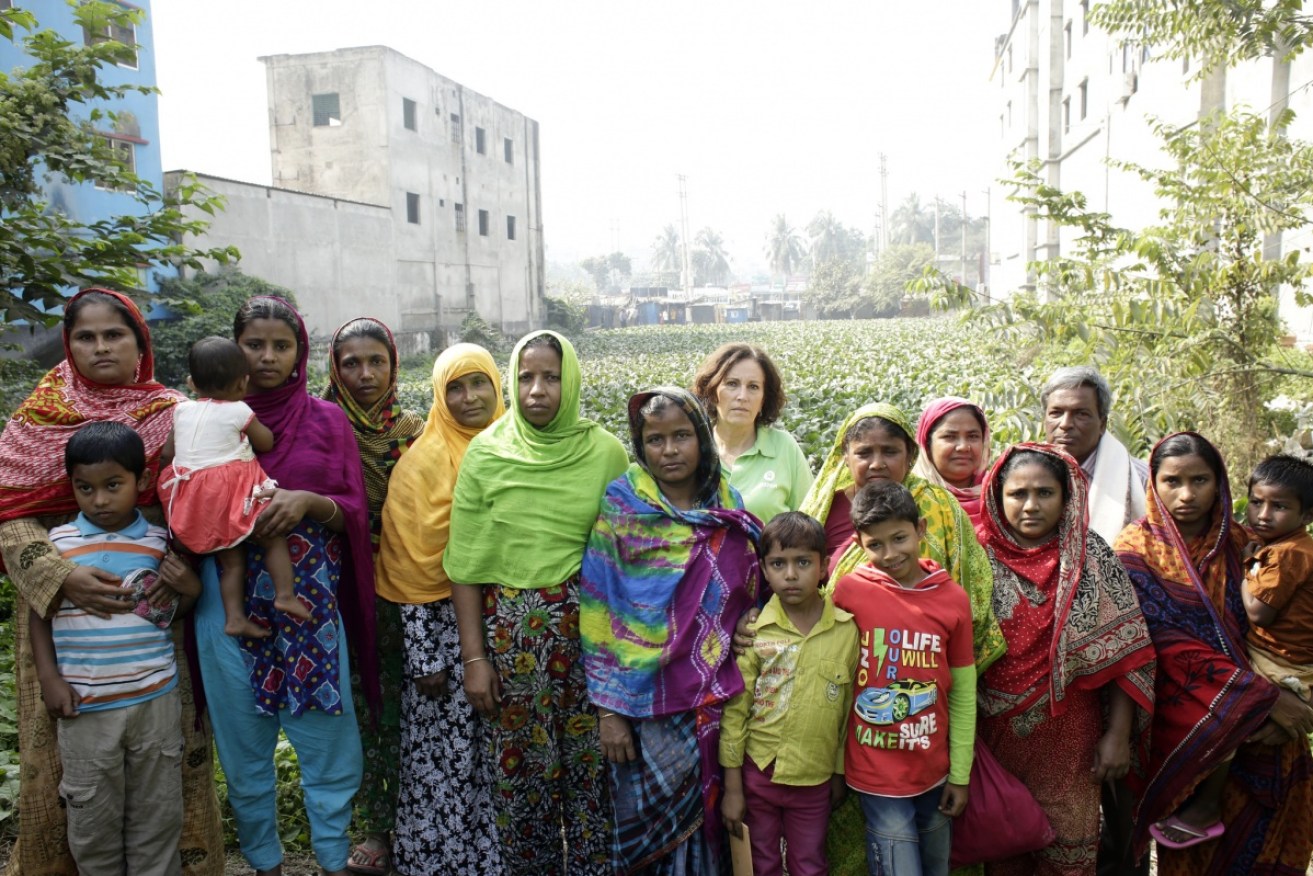Four years after tragedy, fashion industry still cloaked in darkness


Survivors of the Rana Plaza garment factory collapse revisit the site with Oxfam Australia Executive Helen Szoke. Photo: Oxfam
Gathered in their cramped, corrugated-iron room, garment workers Laila, Munni, Marijana and Bilkis tell of a sadly familiar struggle among the hundreds of women living in the Dhaka slum that has become their home.
The women, as young as 12 when they started working gruelling hours in the factories that make clothes for global fashion brands, are battling to survive on salaries that do not allow them to meet their families’ basic needs.
There are common threads among the women’s stories – workers forced to sign pay slips that inflate their salaries, and documents manipulated to avoid the need to pay bonuses. Some of the women are harassed on the walk between their two square metre rooms and work, and some face a humiliating “card system” if they want to go the bathroom outside their break.
Others describe being verbally abused if they fail to meet production targets, while falling pregnant commonly means being forced out of a job.
Often working more than 12-hour days and six-day weeks, many women have spent their monthly pay on food and rent before they even get home on pay day – and then start to worry about how they will survive the rest of the month.
Despite these appalling circumstances, my field visit to Bangladesh just before Christmas left me deeply impressed by the spirit and strength of these women.
It also reminded me of the moment in time four years ago today, when the tragic collapse of the Rana Plaza factory forced us to stop and think. To think about how the clothes we wear are made and the untold stories of the people who make them.
Too many pieces of clothing, our cheap T-shirts and fancy party dresses, hide heartrending real life stories in their stitches. Stopping at the site where the Rana Plaza factory once stood, I replayed in my mind the factory collapse.
Buried under the rubble of the building collapse were more than 1100 lives – mostly women aged 19 to 28. More than 2400 people were injured and many remain missing to this day. Workers were trapped under debris for hours and days before they were rescued. For some, rescue was only possible by amputating limbs. The building developed major cracks the day before it collapsed, but the owner dismissed it as nothing serious.
After the collapse of the Rana Plaza, there was an international outcry and promises of things changing for the better. But when I went to Bangladesh, I found there is still a mountain to climb to ensure the clothes we buy in Australia are not made through the suffering of others.
Following the tragedy, more than 200 international apparel brands and retailers from about 20 countries, two global trade unions, and eight Bangladesh trade unions came together to develop the Bangladesh Accord on Fire and Building Safety, which mandates safety inspections.

Oxfam Australia Chief Executive Helen Szoke meets with Laila, a garment worker at the nearby Nassa Garment Factory, during a visit to a slum in Dhaka, Bangladesh.
Today, 12 major Australian brands have joined the Accord, and I’m proud to say Oxfam has played a part in encouraging them. This is great news, as safety is incredibly important to these workers. But safety isn’t the only issue.
The minimum wage in Bangladesh’s garment industry equates to just $A89 a month – that’s just over $21 a week. What women working in the garment industry need are safe, secure, and well-paid jobs – not jobs that leave them struggling to piece together a living,
After I returned to Australia for Christmas, issues again boiled over in Bangladesh. Garment workers from about 59 factories in Bangladesh protested over poor pay and sub-standard working conditions. More than 1500 workers lost their jobs and 35 people were jailed. The swift crackdown on the protests again sent shockwaves through the global garment industry – many brands joined the call to release the jailed workers and labour leaders.
Companies can help create safe and transparent systems that will support a transformed garment industry. Brands such as Kmart and Target in Australia have been publishing their list of factories all over the world for some time. After some pressure, international brands ASOS and Uniqlo have just joined them. Bringing factories out of the dark means workers and their representatives can more easily raise problems with the brands that are selling their creations.
Today, four years after the Rana Plaza factory collapse, my hope is that more brands will start listening to their workers, and lift the cloak of secrecy on where their clothes are made.
Dr Helen Szoke is the Chief Executive of Oxfam Australia.








